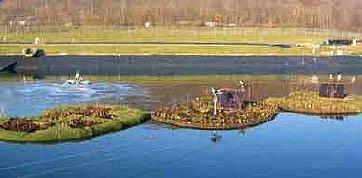If you have always wanted your own island, it is now possible to order one to your specifications. A modest island, say 25 square feet, carries a reasonable price tag usually less than $600. If you have grander plans, such as the 22,000-square-foot island requested by the U.S. Army Corps of Engineers, a rich uncle might come in handy.
Floating Islands International got its start in Bruce Kania’s backyard in Shepherd, Montana. His dog took a dip in the pond and emerged covered in slime and emitting offensive odors. Kania, who is an idea guy, got to thinking about all the nutrient runoff from cultivated fields that was flowing into his pond as well as the nearby Yellowstone River. Based on his experience fishing in pristine Wisconsin lakes with floating islands, it occurred to him that islands might help solve his pond problem and others too.
Today, Kania constructs bio islands from a mesh fabric made from recycled plastic bottles. The material is arranged in layers and then injected with expanding foam that bonds the materials as it dries. Holes are cut into the mesh to insert plants and seeds, and the island is finished with topsoil and sod. Above the waterline, grasses, flowers, and green plants soak up sun while below, their roots grow down through the mesh to absorb water and nutrients.
Ths islands provide a host of water treatment services at a fraction of the cost and with greater efficiency than more traditional methods. They outperform constructed wetlands by more than 200 percent, according to the company, removing nitrates, ammonia, and phosphates while also helping to sequester heavy metals such as zinc and copper. They have the added advantage of taking up no land and adapting to water level fluctuations.
The fact that the islands are a near perfect host for microbes is one of their greatest assets. These nutrient-hungry organisms perform a wide array of water-cleaning services that are hard to replicate through engineering. The matrix of fibers provides a vast surface where microbes can colonize. As they spread, they form a biofilm that works on the nutrients and even collects metal particles too tiny for mechanical filters.
The end results speak for themselves. Phosphates that create dead zones have been sucked out of waterways, algae has been eliminated from ponds, fish habitat has been cooled and cleaned, and the otter exhibit at a Montana zoo has been transformed into an island playground with sparkling clean water. On a larger scale, the Army Corps of Engineers has provided new habitat on an Oregon lake for the Caspian tern in an effort to relocate it away from Columbia River estuary where it gobbles up millions of young salmon every year.
Floating islands are also habitat for many types of birds, ducks, turtles and insects, and they provide food for fish, snails, and other aquatic life. They are deer-safe havens for vegetable gardens and offer the shore-bound viewer stunning displays of flowers as well as restful spots of greenery



